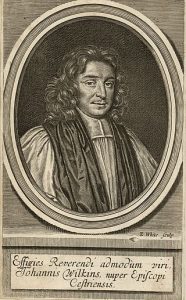 I do seriously, and upon good grounds affirm it possible to make a flying-chariot; in which a man may sit, and give such a motion unto it, as shall convey him through the air. And this perhaps might be made large enough to carry divers men at the same time, together with food for their viaticum, and commodities for traffic. It is not the bigness of any thing in this kind, that can hinder its motion, if the motive faculty be answerable thereunto. We see a great ship swims as well as a small cork, and an eagle flies in the air as well as a little gnat.
I do seriously, and upon good grounds affirm it possible to make a flying-chariot; in which a man may sit, and give such a motion unto it, as shall convey him through the air. And this perhaps might be made large enough to carry divers men at the same time, together with food for their viaticum, and commodities for traffic. It is not the bigness of any thing in this kind, that can hinder its motion, if the motive faculty be answerable thereunto. We see a great ship swims as well as a small cork, and an eagle flies in the air as well as a little gnat.
This engine may be contrived from the same principles by which Archytas made a wooden dové, and Regiomontanus a wooden eagle.
I conceive it were no difficult matter (if a man had leisure) to shew more particularly the means of composing it.
The perfecting of such an invention, would be of such excellent use, that it were enough, not only to make a man famous, but the age also wherein he lives. For besides the strange discoveries that it might occasion in this other world, it would be also of inconceivable advantage for travelling, above any other conveyance that is now in use.
So that notwhithstanding all these seeming impossibilities, it is likely enough, that there may be a means invented of journeying to the moon; and how happy shall they be, that are first successful in this attempt?
― John Wilkins, The Discovery of a New World: or, a Discourse tending to prove, that it is probable there may be another Habitable World in the Moon, with a Discourse of the Possibility of a Passage thither (published in 1638)
Though Wilkins published this half a century before the publication of Newton’s Principia, he had a pretty good grasp of gravitation, though it remained unnamed and its nature baffled him, and could picture well enough the behaviour of bodies in space. He explicitly stated that if there were a tunnel dug through the Earth that intersected its center and ended at its antipodes, an object thrown down it would come to rest, hovering, exactly at the center. Wilkins was a mathematician, and ten years after the Discovery of a New World, published a volume called Mathematical Magick, in which he explained the general principles of mechanics, speculated on possible technological advances in the future (including flight), and urged his readers to pursue scientific studies.
Comments are closed.